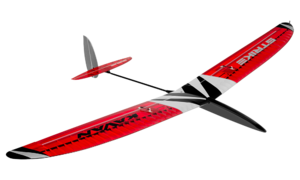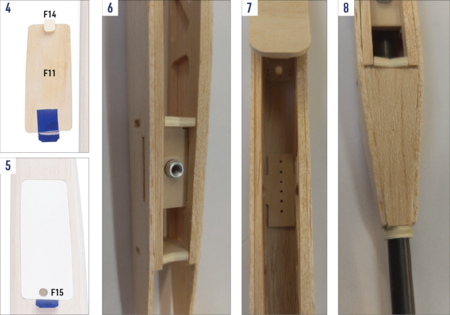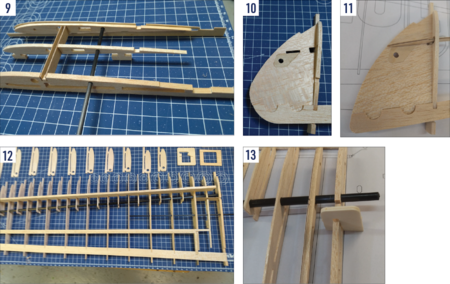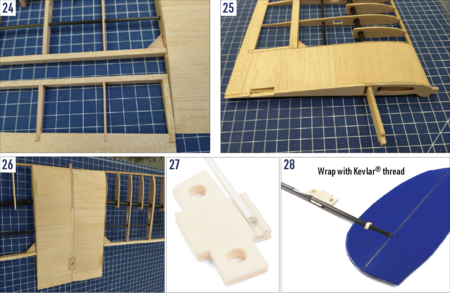KAVAN Strike DLG - Bauanleitung
Einführung
KAV02.8024 KAVAN Strike DLG
Vorsichtsmaßnahmen
Dieses RC-Modell ist kein Spielzeug. Benutzen Sie es mit Vorsicht und befolgen Sie die Anweisungen in dieser Anleitung genau.
Sie sich an die Anweisungen in dieser Anleitung. Bauen Sie das Modell gemäß der Anleitung zusammen. Modifizieren und verändern Sie das Modell nicht. Bei Nichteinhaltung erlischt die Garantie. Folgen Sie der Anleitung um ein sicheres und haltbares Modell nach dem Zusammenbau zu erhalten.
Kinder unter 14 Jahren müssen das Modell unter Aufsicht eines Erwachsenen betreiben. Versichern Sie sich vor jedem Flug, dass das Modell in einwandfreiem Zustand ist, dass alles einwandfrei funktioniert und das Modell unbeschädigt ist.
Fliegen Sie nur an Tagen mit leichtem Wind und an einem sicheren Platz ohne Hindernisse.
Technische Daten
| Spannweite | 1498 mm |
| Length | 1070 mm |
| Fluggewicht | 230 g |
| Profil | YA 0801 |
| Schwerpunktlage | 74–78 mm |
| Steuerbare Funktionen | Querruder, Seitenruder, Höhenruder |
Empfohlene Ausstattung
- KAVAN GO-6MG 2×
- Akku: 1S LiPo 3,7 V 450–500 mAh
Empfohlene Klebstoffe
Wenn nicht ausdrücklich anders angegeben, kleben Sie die Teile mit einem mittelflüssigen Sekundenkleber (KAV56.9952 KAVAN Power CA Sekundenkleber mittelflüssig). Das Brettchen des Flügels kleben Sie mit einem wasserfesten Dispersionskleber (alternativ können alle Holz-Holz-Verbindungen mit Ausnahme der Befestigungen mit einem Dispersionskleber geklebt werden KAV56.9960 KAVAN Dispersionskleber SUPER). Verkleben Sie die Festverbindungen (Flügelwurzeln, Holme, usw.) mit einem 30-Minuten-Epoxidkleber (KAV56.9967), der eine hohe Festigkeit aufweist und ausreichend Zeit für die genaue Ausrichtung der Teile bietet.
Werkzeuge und Hilfsmittel
- Sehr scharfes Modellbaumesser mit auswechselbaren Klingen (z.B. Excel 16001 mit Klinge Nr. 11) KAV66.770
- Schere
- Elektrische Bohrmaschine mit Bohrer-Satz
- Schneidezange
- Zange mit flachen, dünnen Backen
- Flach- und Kreuzschraubendreher
- Rasiersäge
- Schleifpapier 80, 100, 180, 360-400er Körnung
- Nadelfeilen-Set
- Lötkolben mit Lot
- Wäscheklammern, Büroklammern, Schraubzwingen
- Modellbau-Stecknadeln
- Stäbchen und kleine Dose zum Epoxidmischen
- Abdeckband, klares Selbstklebeband
- Spiritus (zum Abwischen von überschüssigem Epoxid)
- Papierserviette oder ein sauberes Tuch (zum Abwischen von überschüssigem Epoxid)
- Stahllineal
- Rechtwinkliges Dreieck
- Dünne transparente Polyethylen-Folie
- Alkoholmarker mit dünner Spitze
- Profi-Bügeleisen, bzw. Heißluftpistole für die Folien-Bespannung
- Leichter Balsa-Filler
- Schmelzkleberpistole + Schmelzkleber
Hinweis
Das RC Modell, das Sie bauen und mit dem Sie fliegen werden, ist kein Spielzeug! Auch wenn es Ihnen beim Fliegen leicht und langsam vorkommen kann, ist es fähig, bei der falschen Benutzung eine ernsthafte Verletzung oder einen Vermögensschaden zu verursachen. Es liegt nur an Ihnen, ob Sie das Modell richtig bauen, das RC Set und den Motor richtig installieren, das Modell einfliegen und weiter im Einklang mit üblichen Regeln (und auch mit Bauernverstand) fliegen werden. Wenn Sie gerade mit RC Modellen beginnen, bitten Sie um Rat in Ihrem Modellbaugeschäft oder einen erfahrenen Modellbauer im lokalen Modellbauklub, damit Sie einen guten Instruktor finden.
Vorsichtsmaßnahmen
Bauen Sie das Modell genau nach der Anleitung. Ändern Sie oder passen Sie das Modell auf keine Weise an. Sonst riskieren Sie, dass das Modell gefährlich oder unbeherrschbar sein kann. Finden Sie Zeit für den Bau, bauen Sie alles fest und zuverlässig. Benutzen Sie ein entsprechendes RC Set und andere Ausstattung, die im perfekten Zustand ist; installieren Sie richtig alle Teile des Modells und überprüfen Sie ihren Betrieb und Funktionieren vor dem ersten und vor jedem nächsten Flug. Wenn Sie kein erfahrener RC Pilot sind, fliegen Sie nur mit Hilfe eines erfahrenen Modellbauers.
Bau des modells
Leitwerke
- Bereiten Sie und richten Sie die Leitwerksteile trocken aus. Schleifen Sie nach Bedarf. (Abb. 1)
- Rauen Sie die Oberfläche des Kohlefaser-Streifens 3×0,5 mm R3 mit dem Schleifpapier Nr. 120 leicht auf. Kleben Sie ihn mit einem mittelflüssigen Sekundenkleber an die Endleiste der Flosse.
- In das Höhenleitwerk T1 kleben Sie die Strebe T3 aus Pappel-Sperrholz. Nach dem Aushärten des Klebstoffs schleifen Sie die Strebe in eine Ebene mit dem Leitwerk.
- Schleifen Sie die Oberfläche aller Leitwerksteile mit dem Schleifpapier Nr. 120 und runden Sie ihre Kanten ab. Die Nasenleiste des Seiten- und Höhenruders schleifen Sie in einen Winkel nach Det. D–D.
- Die Leitwerke werden nach dem Aufkleben des Leitwerkbettes auf den Leitwerksträger fertiggestellt (siehe Rumpfbau).
Rumpf
- Bereiten Sie die Teile der Rumpfgondel vor. Richten Sie sie trocken aus, ohne sie zu verkleben. Schleifen Sie sie nach Bedarf. Stellen Sie sicher, dass der röhrenförmige Leitwerksträger aus Kohlefaser F1 leicht, aber gut in die Öffnungen in den Spanten F10 und F8 passt.
- Kleben Sie die Balsastrebe F2L (mit Ausschnitt für den Lukenverschluss F14) an die Innenseite der linken Seitenwand F3L (mit großem Ausschnitt für die Kappe F11). Kleben Sie die Balsastrebe F2R an die Innenseite der rechten Seitenwand F3R (ohne Ausschnitt für die Kappe). (Abb. 2)
- Kleben Sie den Verschluss F14 an die Vorderkante der Elektronikfachkappe F11, so dass sie in den Ausschnitt in der Seitenwandstrebe F2L passt und die Kappe frei in das Loch in der Seitenwand F3L gleiten kann. Kleben Sie ein Paar Magneten F15, die als Kappenverschluss dienen, mit einem 5-Minuten-Epoxidkleber in die Löcher in der Kappe F11 und in der Strebe F2L erst nach der Bespannung des Rumpfes, um zu verhindern, dass die Magneten durch hohe Temperatur entmagnetisiert werden. Achten Sie auf ihre Polarität. Sie müssen sich anziehen! (Abb. 4+5)
- Kleben Sie die Aluminiummutter der Flügelbefestigungsschraube M4 in die Sperrholz-Trennwand F9 von unten mit einem Epoxidkleber. Schleifen Sie die Rumpftrennwände und Spanten im Voraus in einen Winkel ab, wo es nötig ist. (Abb. 6+3)
- Kleben Sie die Rumpftrennwände und Spanten F10, F9, F8, F6 mit einem 30-Minuten-Epoxidkleber schrittweise von hinten nach vorne zuerst in eine Seitenwand und dann legen Sie die zweite. Legen Sie die Gondel auf den Bauplan, der durch eine dünne klare Kunststofffolie geschützt wird. Überprüfen Sie, dass sie gerade und nicht verdreht ist – nach Bedarf pinnen Sie sie auf die Arbeitsplatte nach dem Aushärten des Klebstoffs an. (Abb. 5)
- Dann kleben Sie den Spant F4, den im Voraus in den Winkel abgeschliffenen Bugfüller F5 und die Trennwände F17 und F18.
- Kleben Sie die Hochstarthakenplatte F7 mit einem Epoxidkleber an das untere Rumpfteil. (Abb. 7)
- In Höhe der vorderen Trennwand F10 schneiden Sie beide Seitenwände (bis zu einer Tiefe von ca. 0,5–1 mm) an und brechen Sie sie vorsichtig an. Setzen Sie den Leitwerksträger F1 in die Öffnungen in den Trennwänden F8 und F10 ein – kleben Sie noch nicht.
- Setzen Sie den Sperrholzring F21 an den Leitwerksträger F1 ein und kleben Sie beide Seitenwände punktuell an ihn. (Achten Sie darauf, dass der Leitwerksträger immer herausgenommen werden kann). Kleben Sie die Teile der oberen und unteren Bespannung F20 und F19. (Abb. 8)
- Kleben Sie die untere Bespannung des Rumpfes F16 und die obere Bespannung aus drei Teilen F13a, F13b und F13C.
- Schleifen Sie die ganze Gondel (mit der eingelegten Kappe F11) fein, damit alle Teile einschließlich Ring F21 reibungslos auf das Rohr des Leitwerksträgers passen.
Wing
- The wing is to be built directly on the building plan protected by a thin sheet of clear plastic film. The wing ribs and riblets are supplied with jig tabs on the bottom side to allow building the wing with an under-cambered profile on a flat surface; at the same time producing the washout (the wing trailing edge is higher by 3 mm at the tips than at the root) necessary for a stable flight of the model. DO NOT CUT the mounting jigs; they will be removed only after the entire wing has been built. There is also the rib spacing jig to correctly set the leading edge ends of rib and riblet mounting jigs. (Fig. 12)
- Epoxy together the wing central ribs W5 and W6; insert 3 mm beech dowels into the holes to obtain the correct match. Note: Make a left and right pair of assemblies. (Fig. 9)
- Glue the plywood reinforcement plate W39 (for the W64 DLG pin) into the wing tip W35 and then the wing tip to the trailing edge W30 on a flat working surface; glue the W36 and W37 reinforcement plates in place creating a notch for the plywood wing tip spar W38. (Fig. 10 + 11)
- Thread all the wing ribs and riblets W3 to W32 onto the main spar carbon tube W60; use a round file to trim the openings in the ribs to set the ribs at the required angle. Thread the auxiliary carbon rod spar W61 through the respective holes in the W3 to W12 ribs. (Fig. 12)
- Put the main spar with ribs onto the building plan and insert the ends of ribs into the corresponding notches in the trailing edge W44 (W45 for the right-wing half). Insert the front ends of the rib jig tabs into the corresponding notches of the rib spacing jig. Align all the parts to the correct position over the building plan; pin down where necessary and then glue the ribs W4 to W31 to the W60 main spar tube, W61 auxiliary spar and the trailing edge. Epoxy the wing tip spar W38 into the main spar tube and to the wing tip into the notch between the W36 and W37 reinforcement plates. Glue the wing tip to the W32 rib and finally, the W32 rib to the main spar and trailing edge. Glue the balsa gusset W33 between the W32 rib and the W31 riblet.
- Glue the root rib W3 using the root rib dihedral jig in place. (Fig. 13)
- Trim the notches for the leading edge W46 (3 mm beech dowel) in the ribs and riblets as necessary. Glue the leading edge (starting from the wing tip and then rib by rib towards the wing root). (Fig. 14)
- Insert the W47 rear spar and the W48 aileron leading edge into the corresponding notches in ribs W4 to W32. Align them both flush with the upper edge of the ribs but do not glue yet.
- Glue the W51 aileron servo frame together with the W52 upper cover plate between the W12 and W14 ribs from above (the opening in the frame fits KAVAN GO-06MG servos; you might have to trim it if other servos are used). Glue the aileron W62 root and W63 tip ribs in place - to the W48 aileron leading edge and W44(45) trailing edge ONLY. Glue the W50 aileron horn block between the W12 and W14 ribs; flush with the upper edge of the ribs and the W48 aileron leading edge. (Fig. 15+16)
- Glue the W34 reinforcement plate between the W30 and W32 ribs, glue the W40 and W41 reinforcements to the wing tip, and glue the two W49 gussets in place. (Fig. 17)
- Epoxy the plywood wing joiner bay plates W43 into the W3, W4 and W5/W6 ribs - be sure the bay will accommodate the W42 wing joiner nicely. (Fig. 20)
- Thoroughly check the entire wing, you are almost there; the wing sports the required 3 mm washout at the tip due to the rib mounting tabs now. Once satisfied, apply cyano to all joints. Note: The W47 rear spar and the W48 aileron leading edge are supposed to be glued to the ribs ONLY, not to each other!
- Now you can carefully cut the rib jig tabs using a sharp modeller’s knife.
- Soak the W51 aileron servo frame and W52 plate with thin cyano or thinned epoxy from the inside. Glue the W53 bottom aileron servo cover between the W12 and W14 ribs. (Fig. 18)
- Sand the bottom side of all ribs and riblets to shape with No. 120 sandpaper.
- Glue the bottom wing centre 1.5 mm balsa sheeting W57 (with a rectangular opening for the aileron servo cable) and W58 in place; glue the plywood reinforcement plate W54 on the top of W58 along the area of the wing fixing bolt. (Fig. 19+20)
- Thread a thick sewing thread through rectangular openings for the aileron servo cable in the W4 to W12 ribs and W57 bottom sheeting and secure it with pieces of sticky tape - it will help you to navigate the aileron servo cable through later.
- Glue the top wing centre 1.5 mm balsa sheeting W56 and W55 in place. Sand the wing root flush with the W3 rib - the slanted position set with the root rib dihedral jig ensures the correct wing dihedral. (Fig. 21)
- Use a fine razor saw and modeller’s knife blade to cut through the ribs and trailing edge to separate the aileron from the wing. Bevel the aileron leading edge by 30° following the Det. A-A. Finally, sand the entire aileron smooth using No. 180 sandpaper. (Fig. 23+24)
- Assemble the other wing half in the same way.
- Sand both two wing halves with No. 120 sandpaper. Trial fit - no glue yet - the wing halves and the W42 wing joiner; insert the riblets W1 and W2 between the root ribs. Once satisfied with the fit, epoxy the W42 wing joiner, and W1 and W2 riblets to one wing half aligned to match the wing root rib. (Fig. 25)
- Put the wing half with the wing joiner glued in on your workbench (protected by a sheet of plastic film) so the alignment pin of the W1 riblet protrudes over the edge of the table; then epoxy the other wing panel. Be sure the trailing edges of both wing panels match perfectly. Double-check the correct wing halves alignment and let the epoxy set. (Fig. 26)
- Epoxy the wing bolt plate W59 to the top of the wing centre; once the glue has cured drill a 4.2 mm hole for the wing bolt through the W59. (Fig. 26)
- Now it is the time to decide which tip of the wing the discus launch pin is to be glued into - the left tip for a right-handed pilot, the right tip for a left-handed pilot. Laminate a strip of the fibreglass cloth around the hole for the discus launch pin on top and bottom of the wing tip. You can use a special low-viscosity laminating/finishing epoxy or a regular epoxy glue thinned slightly by an epoxy paint/dope thinner. Once the resin has cured, sand the entire wing smooth with No. 180 sandpaper.
Covering
- Thoroughly sand the surface of all parts with No. 360–400 sandpaper and carefully vacuum all the dust (the iron-on film does not stick well to a dusty surface; the dust also contains hard grains released off the sandpaper capable of ruining the smooth coating of your sealing iron quickly).
- Use as light iron-on film, as you can get (transparent KAVAN iron-on film, Oracover®, Oralilight® etc. – not supplied in the kit). Follow the instruction manual supplied with the covering film of your choice please.
Final Assembly
Hinging the Control Surfaces
- Use high-quality hinging tape strips (available in hobby shops) or strips of the same iron-on film you used for the covering. Remember to apply the tape with the control surface deflected to the limit (refer to Det. D-D) to get free movement of the particular control surface.
Fuselage and Tail
- Using a very sharp pointed modeller’s knife, cut the covering film over the opening for the tailplane pylon in the horizontal stabilizer, over slots for the Kevlar® thread in the fin and over control horn slots in the elevator and rudder.
- Use a fine needle file to trim the pre-cut slots for the horizontal tailplane pylon, fin, and elevator and rudder push rod exits in the carbon tube tail boom. Use a fine round needle file to make a groove for the rudder push rod tube in the tailplane pylon F22. (Fig. 27)
- Insert the tailplane pylon F22 into the F1 tail boom - no glue yet. Insert the fin and rudder assembly into the notch at the end of the tail boom and tack glue it to the tail boom. Bind the fin to the tail boom with a Kevlar® thread threaded through the slots in the fin. (Fig. 28)
- Slide the horizontal stabilizer on the F22 tailplane pylon; align it square to the fin and to the longitudinal axis of the tail boom and tack glue it to the pylon. Double-check the correct alignment; once satisfied, apply a generous amount of cyano along all the joints and onto the Kevlar® thread. Insert the elevator and rudder push rod outer tubes into the tail boom. Secure them with a piece of polyurethane foam soaked with epoxy that you will work into the centre of the tail boom with a thin stick. This is great for a precise, pushrod backlash-free elevator and rudder control. (Fig. 29)
- The F12 servo mount supplied in the kit has been tailored for the recommended KAVAN GO-6MG servos. Whatever type of servos you use, always check if the openings don’t need trimming first. We recommend soaking the edges of the servo openings with cyano. Once satisfied, glue the F12 servo mount in place (the servos are to be fitted in the upside-down position). (Fig. 30)
- Thread the protruding ends of the elevator and rudder push rod outer tubes through the holes in the F6 former so the tubes lead directly to the horns of servos in the F12 servo mount. Insert the tail boom into the fuselage - no glue yet. (Fig. 31)
- Attach the wing to the fuselage and secure it with the M4 bolt. Looking from above, front and rear check the fuselage and tail boom are straight and the wing dihedral makes a nice symmetrical "V" in relation to the horizontal stabilizer. Once satisfied cut the push rod outer tubes to the correct length and epoxy thoroughly the tail boom into the fuselage. Double-check the correct alignment before the glue sets.
- Solder the M2 brass threaded couplers on one end of the 0.8mm piano wire push rods. Screw the ball links on and slide the push rods into the respective outer tubes. Secure the ball links to both two servo arms with the M1.6 screws supplied in the kit. Insert the fibreglass control horns into the slots in the elevator and rudder - do not glue yet. Set the servos to the neutral with your radio on; attach the servo arms square to the side of the servo case. Set the elevator and rudder flush with the horizontal stabilizer resp. fin. Mark the correct length of the push rods and bend them to the right angle (you can make a "Z-bend", but the simple L-bend usually works well enough). Insert the L-bends into the holes in the control horns and cyano the horns into the elevator and the rudder in place, set in the neutral position. Finally, secure the servos with drops of hot-melt glue, silicone or MS polymer glue in the servo tray. (Fig 29+32)
- Epoxy the pair of F15 magnets into the F11 hatch and fuselage. Double-check their polarity - they have to cling to each other! For easy removal, apply a strip of folded sticky tape to the rear edge of the hatch. (Fig. 4+5)
- Install your receiver into the fuselage, under the wing. The receiver battery will go into the nose.
Wing
- Thoroughly epoxy the carbon discus-launch pin into the left (for a right-handed pilot) or right (for a left-handed pilot) wing tip. (Fig. 33)
- Remove the covering film over the openings for the aileron servo arms in the W52 top cover plates and in the W53 bottom cover plate. Install aileron servos with arms fitted (set them to neutral with your radio on), aileron horns and linkage the same way you did with the rudder and elevator. Finally, using a piece of sticky or iron-on film seal the opening in the W53 bottom cover plates. (Fig. 34+35)
Tow Hook
- Install the tow hook into one of the pre-drilled holes in the F7 tow hook plate; it should be positioned about 5 mm in front of the centre of gravity. (Fig. 36)
Recommended Control Surface Throw, CG Position
- CG Position: 74–78 mm
- Rudder: ±25 mm
- Elevator: ±10 mm
- Ailerons: 10 mm up, 6 mm down
- Ailerons as the airbrake: 40 ° down
- Discus launch configuration: rudder -1 mm against the direction of the launch (right-handed - rudder 1 mm right), elevator 1 mm down.Note: Use this configuration for the climbing phase of the discus launch only after the model has been trimmed out properly and you‘ve made yourself familiar with the controls.)
- Airbrake → elevator mix: elevator 2 mm down at full airbrake.
Flying
Be sure you are using fully charged batteries. Now (and before any further flight) check the correct function of the whole radio equipment, motor and moving of control surfaces. Be sure any part of flight equipment cannot move during flight. We strongly recommend making a range check (see your radio instruction manual for details).
The first flight: Wait for a calm day. Fly only on a safe site such as an RC club flying field. Glider will be very happy on your favourite slope on a calm day. The very light lift will allow perfect fine trimming out.
Switch your transmitter and then the receiver on and check all the working systems once more. Facing INTO the wind hold your transmitter in one hand; grip the model in the other hand near the centre of gravity. Hold it at head level and give the model a fairly powerful push exactly into the wind; wings level, nose slightly down. Your model should now glide in a long, flat and straight path, without needing any help from you. Use the controls gently if necessary, and adjust the trim tabs until your STRIKE DLG glides the above-described way. Now check the position of control surfaces; set the length of pushrods to bring back trim tabs on your transmitter to the central position if necessary (we strongly recommend doing it in any way). Check again the gliding of your STRIKE DLG.
Now you are ready to make your first discus launch.
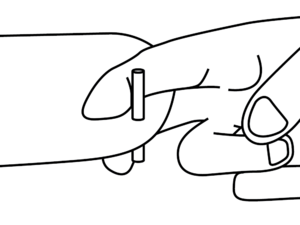
Discus Launch
The discus launch allows your model to reach quite a high altitude without much effort. Like with any "sports performance", it will require some training to do it right. Our step-by-step manual makes it easy. We will describe the procedure for a right-handed pilot; with the launching pin attached to the left wingtip. The "left-handed" procedure is the mirror image.

Position A - Getting ready
Your right index and middle fingers should be wrapped around the launch pin at the left wing tip. Your thumb is to be gently pressed against the leading edge of the wing. Stand with your left shoulder into the wind and the right wing tip pointing at ca 45° angle to the ground.

Position B - The first step
Take a long step with your left foot pulling the STRIKE DLG up and forward with your right arm.

Position C - Rotation
Start rotating to the left keeping the STRIKE DLG flat and your right arm extended.

Position D – Continued rotation
The second half of the rotation - the most important part for a good launch. Do not use too much arm in this section. Just let the swing of your torso speed the STRIKE DLG up.

Position E - Release
By this time in the launch the plane will be trying to climb on its own. Just release your fingers and let the plane fly out of your hand directly into the wind.
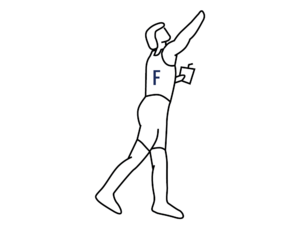
Position F – Taking the control
Catch your balance; watch your STRIKE DLG climb whilst getting hold of your radio, ready to control your model. The plane will climb after release – the climb angle should be shallow at first; once you are well acquainted with the discus launch you can use more force and increase the launch angle to 60–80 degrees. When completely familiar and comfortable you can add two quick steps before starting the turning sequence, to get some extra speed and energy.
When the plane has slowed almost to the point of stopping push full down elevator to achieve level flight. When this is done at the right moment the plane will go into horizontal flight with just enough airspeed to maintain a gentle glide. If it is done too early the plane will pitch up her nose dangerously after a short dive. If it is done too late the plane will stall.
Go catch some thermals and enjoy your new STRIKE DLG.
Parts list
| Main parts | |||
|---|---|---|---|
| Part | Quantity | Building plan no. | Material |
| Building Plan 1:1 | 1 | ||
| Instruction Manual | 1 | ||
| Sheet of Stickers | 1 | ||
| Pushrod set | 2 | Plastic tube + 0.8mm piano wire | |
| Tail boom | 1 | F1 | Carbon tube Ø7/6 mm |
| Rib Spacing Jig | 1 | Balsa 1.5 mm | |
| Bag no. 1 - small parts | |||
| Tow hook | 1 | Metal | |
| Magnet Ø3 mm | 2 | F15 | Neodymium |
| Wing Bolt M4 | 1 | Nylon | |
| Captive nut M4 | 1 | Aluminium | |
| Rudder Horn | 4 | Fibreglass 1.5 mm | |
| Ball link short M2 | 4 | Balsa 1.5 mm | |
| Threaded coupler M2/0.8mm | 2 | Brass | |
| Rudder and elevator servo tray | 1 | F12 | Balsa 4 mm |
| Carbon pin | 1 | Ø5 mm | |
| Fibreglass cloth | 1 | 110 g/m² | |
| Kevlar ® Thread | 1 | ||
| Quicklink | 2 | ||
| Quicklink pin | 2 | ||
| Aileron push rod | 2 | Carbon rod Ø2 mm | |
| Bag no. 2 | |||
| Nose block | 1 | F5 | Balsa 10 mm |
| Servo hatch | 1 | F11 | Plywood 1.2 mm |
| Fuselage Former | 1 | F6 | Plywood 3 mm |
| Fuselage Formers | 1+1+1 | F4+F8+F10 | Lite Ply 3 mm |
| Fuselage cross-brace | 1+1 | F17+F18 | Lite Ply 3 mm |
| Fuselage hatch lock | 1 | F14 | Lite Ply 3 mm |
| Tail boom fairing ring | 2 | F21 | Lite Ply 3 mm |
| Wing riblet | 1 | W2 | Lite Ply 3 mm |
| Root rib dihedral jig | 1 | Lite Ply 3 mm | |
| Nose Shape Template | 1 | Lite Ply 3 mm | |
| Bag no. 3 | |||
| Wing rib | 2 | W6 | Plywood 0.8 mm |
| Wing centre sheeting reinforcement | 2 | W54 | Plywood 0.8 mm |
| Wing joiner bay plate | 4 | W43 | Plywood 0.8 mm |
| Towhook plate | 1 | F7 | Plywood 2 mm |
| Wing captive nut brace | 1 | F9 | Plywood 2 mm |
| Wing bolt plate | 1 | W59 | Plywood 2 mm |
| Wing tip spar | 2 | W38 | Plywood 2 mm |
| Wing riblet | 1 | W1 | Lite Ply 3 mm |
| Wing joiner | 1 | W42 | Lite Ply 3 mm |
| Wing tip reinforcement plate | 2 | W39 | Lite Ply 1.5 mm |
| Bag no. 4 - tail | |||
| Horizontal stabilizer | 1 | T1 | Balsa 2.5 mm |
| Elevator | 1 | T2 | Balsa 2.5 mm |
| Horizontal stabilizer reinforcement plate | 1 | T3 | Balsa 2.5 mm |
| Fin | 1 | R1 | Balsa 2.5 mm |
| Rudder | 1 | R2 | Balsa 2.5 mm |
| Carbon fin reinforcement | 1 | R3 | Carbon strip 0.5×3 mm |
| Tailplane pylon | 1 | F22 | |
| Bag no. 5 | |||
| Wing rib | 2 | W6,8,10,12,14,16,18,20,22,24,26,28 | Balsa 1.5 mm |
| Wing riblet | 2 | W7,9,11,13,15,17,19,21,23,25,27,29,31 | Balsa 1.5 mm |
| Wing root rib | 2 | W3 | Balsa 4 mm |
| Wing tip rib | 2+2 | W30, W32 | Balsa 4 mm |
| Wing rib | 2+2 | W4, W10 | Balsa 3 mm |
| Trailing edge | 1+1 | W44, W45 | Balsa 3×15 mm |
| Leading edge | 2 | W46 | Beech dowel Ø3 mm |
| Wing tip reinforcement (bottom) | 2+2 | W36,W37 | Balsa 4 mm |
| Wing tip reinforcement (top) | 2+2 | W40, W41 | Balsa 4 mm |
| Wing tip | 2 | W35 | Balsa 1.5 mm |
| Gusset | 4 | W49 | Balsa 1.5 mm |
| Wing main spar | 2 | W60 | Carbon tube Ø6/5 mm |
| Auxiliary spar | 2 | W61 | Carbon tube Ø3 mm |
| Rear spar | 2 | W647 | Balsa 4 mm |
| Aileron leading edge | 2 | W48 | Balsa 4 mm |
| Aileron root/tip rib | 2+2 | W62, W63 | Balsa 4 mm |
| Aileron servo frame | 2 | W51 | Balsa 4 mm |
| Aileron servo top cover plate | 2 | W52 | Balsa 1.5 mm |
| Aileron servo bottom cover plate | 2 | W53 | Balsa 1.5 mm |
| Aileron horn block | 2 | W50 | Balsa 4 mm |
| Wing centre sheeting | 2+2+2+2 | W55, W56, W57, W58 | Balsa 1.5 mm |
| Bag no. 6 | |||
| Fuselage side | 1+1 | F2L/R | Balsa 1.5 mm |
| Fuselage bottom sheeting | 1 | F16 | Balsa 2.5 mm |
| Fuselage upper sheeting | 1+1+1 | F13a, b, c | Balsa 2.5 mm |
| Fuselage side reinforcement plate | 1+1 | F2L/R | Balsa 3 mm |
| Tail boom fairing | 1+1 | F19, F20 | Balsa 2.5 mm |
